25/26th May 1943




Aircrew
Squadron
RAF 7 Squadron based in May 1943 at Oakington.
Aircraft
The Stirling was the first British four-engined bomber of World War II. It was very agile and praised for its ability to out-turn enemy night fighters and for its good handling characteristics. It was popular with crew because it was much quieter inside than Lancasters but its relative poor altitude ceiling was often a subject of criticism. When Stirlings were on operations with other RAF bombers which could fly higher, the Luftwaffe tended to concentrate on the Stirlings.
The Aircraft Movement Form 78 (below) [14] shows that this aircraft was a Stirling Mark I, Serial No: EF361, powered by Bristol Hercules XI engines. It was bulit by Short Brothers Ltd under Contract No. 763825/38 and delivered to RAF Maintenance Unit No. 32, St. Athan in South Glamorgan on 24th March 1943. It was transferred to RAF 7 Squadron on 6th April 1943 and given the identifcation MG-B. It was recorded as Category E (write off) on 26th May 1943 and Struck Off Charge (SOC) on 28th May 1943.

Squadron
RAF 7 Squadron based in May 1943 at Oakington
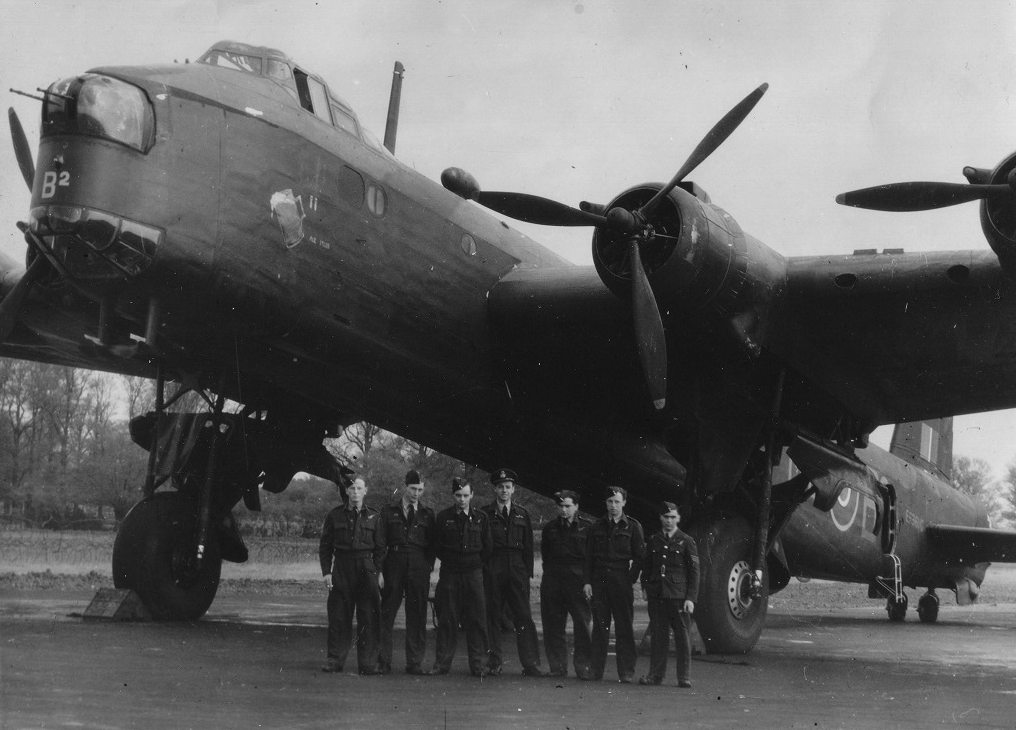
This photograph was provided by Ron Birch of Gold Coast, Queensland, Australia whose Great Uncle Albert Fisher is of one of the crew who perished when MG-B crashed. The serial number EF361 can be seen behind the crew access hatch at the rear of the aircraft. Added to the serial number is 'G' which indicates that the plane was be guarded when on the ground [10].

This suggests it was fitted with secret or sensitive equipment in its role as one of the PFF (Pathfinder Force) aircraft. According to Bomber Command Night Raid Report No. 337 covering the night this plane was lost, all 'Practice Y' aircraft fitted with the new H2S radar system, returned safely from the Düsseldorf raid. However, there is compelling evidence that this aircraft was fitted with H2S equipment shortly after this photograph was taken (see Luftgaukommando VI Münster Report below).
MG-B carried a nose emblem 'ALE ITLER' and glass of beer motif (below). The two bomb symbols indicate that the aircraft had completed two bombing missions at the time of the photograph.
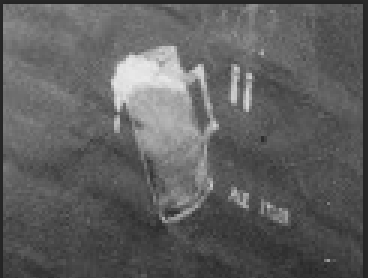
The colourised crew photograph below shows (left to right): Walter Denham | William Hills | Noel Lagna | Joseph Berthiaume | Alwyn Brotherton | Albert Fisher | Eric Broadhead
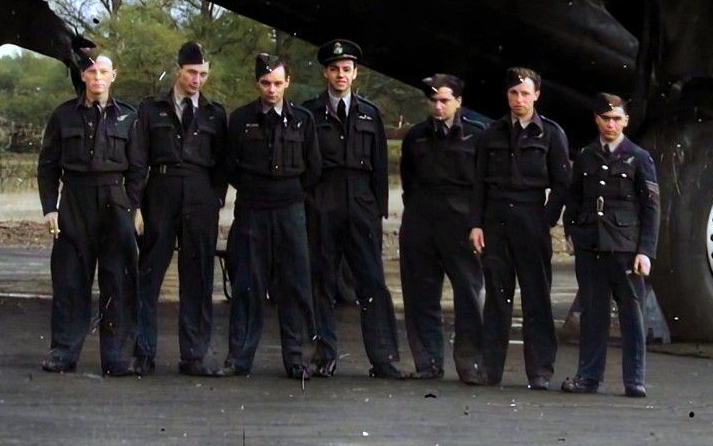
EF361 had taken off from Oakington at 23.57 on 25 May 1943 on a bombing mission to Düsseldorf, when it was caught in the blast from Halifax bomber KN-D at an approximate height of 4700 metres (15,400ft) and crashed 2km south of Jülich. German sources indicate that the wreckage of the aircraft was discovered between Jülich and Heckfeld near the old manor house at Lorsbeck and the Jülich Railway Ausbesserungswerk (Repair Works).
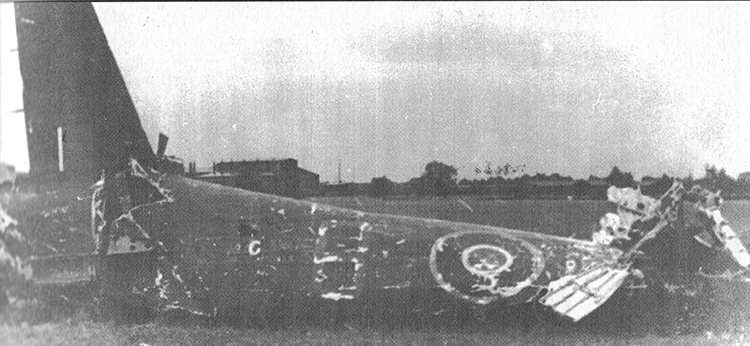
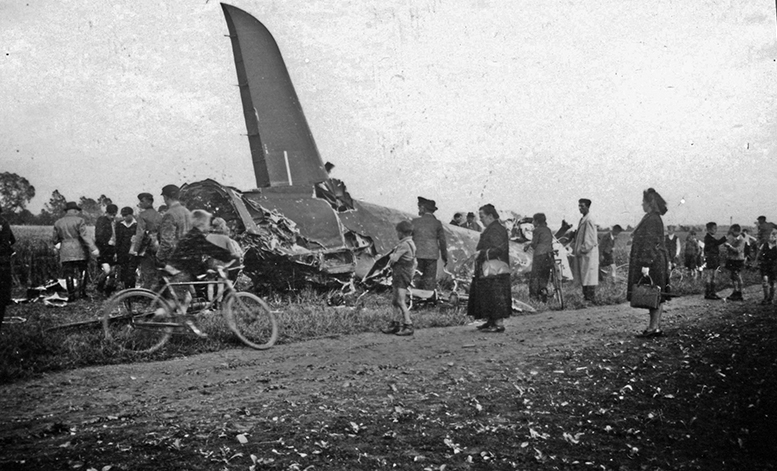
Luftgaukommando VI Münster Report
Whenever an allied aircraft crashed in Germany, or in German occupied territory, the scene was very quickly quarantined. Looting was severely punished, because wreck recovery teams wanted to remove and examine as much equipment as possible to discover whether the downed aircraft was fitted with any hitherto secret devices. It is therefore surprising to see so many members of the general public so close to the crash site in the picture above. A Luftgaukommando was an administrative command of the Luftwaffe responsible for air defence and support services. Luftgaukommando VI, based in Münster, was responsible for the area around Jülich. It published a report "Untersuchung von Nachrichtegërat in abgeschossenen Feindflugzeugen" on 28th May 1943 covering the previous two nights' raids, detailing the electronic equipment that had been discovered in the crashed bombers [13]. A scan of the original report into EF361 is shown in German on the left, and the translation into English on the right
Untersuchung von Nachrichtegërat in abgeschossenen Feindflugzeugen |
Investigation of Communication Devices in Downed Enemy Aircraft |
|---|---|

|
3.) Julich-Heckfeld: |
A 'Rotterdam' device was the nickname given by the Germans to the top secret H2S ground scanning radar system after they had captured one on only its second operational mission: a 7 Squadron Stirling R9264 was fitted with the device when it was shot down near Rotterdam by Oblt.Frank and his Bordfunker Fw. Gotter of 2./NJG1 in box Gorilla on the evening of 2nd February 1943 [10]. The RAF Stores reference number of 10AB/1369 was the Type 3 rotating radar dish attached to the underside of the plane. This was a prototype model, later replaced by the Mk. II. Unlike the transceivers etc. which were just bolted inside the aircraft wherever they had space, the scanner was a permanent fixture under the aircraft, and would have been covered by a radome. The fact that a radome cannot be seen in the crew photograph at the top of the page suggests it must have been fitted shortly after the picture was taken. The extract below is taken from the Ministry of Aircraft Production guide to the H2S Mark II and A.S.V. Marks IIIA and IIIB Handbook. [12]

Receiver Type R3090 was an IFF (identification Friend or Foe) Transponder.
Area Navigation Device R1355 was the superheterodyne receiver for the GEE Navigation System.
Radio Landing Receiver R1124 was part of the Lorenz 'Blind Approach' Landing system which homed in on three ground transmitters to aid in the approach to a friendly airfield. [11]
Loss Card
Bomber Command created a Loss Card [14] for each aircraft that failed to return from an operational flight. The data recorded on the cards normally includes the names of the crew, their fate, the route taken and bomb load. The handwriting is notoriously difficult to decipher. In some cases information from survivors has also been added, and post-war research regarding the crew and aircraft. Some of the most valuable information came from personnel of the Missing Research and Enquiry Service (MRES) working on the ground in the areas where the aircraft were lost.

The front of the Loss Card for EF361 shows the planned route was 51 45N 03 50E to 50 55N 06 36E to Dusseldorf to 51 17N 00 30E to Noordwijk.
The Loss Card shows a reference number followed by the numbers for each body found (whether identified or not). The reference is 154/39-46 where 39= Berthiaume, 40= Lagna, 41= Fisher, 42= Hills, and 44= Brotherton. Interestingly, 43 and 45 refer to two of the crew of Stirling BF534 which crashed at the same time as EF361. 46 was an unidentified body. The fate of Denham and Broadhead is not recorded, so one may have been the unidentified body.

The rear of the Loss Card reads:
154/39-46 5 identified + 1 unknown + 2 of crew of 15/L [Stirling BF534 was from 15 Squadron with the code letter L]
Shot down 26.5.43. Burial not reported
Flight Simulator
If you want to know what it was like to fly in MG-B, you can download a repainted version of Microsoft Flight Simulator's Short Stirling bomber, specially commissioned from programmer Jan Kees Blom by Albert Fisher's great nephew Ron. You can download it here. Important note: you will need to install MSFS Virtavia Short Stirling Package first, which can be downloaded here.